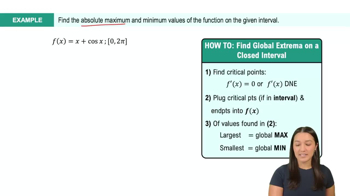Table of contents
- 0. Functions7h 52m
- Introduction to Functions16m
- Piecewise Functions10m
- Properties of Functions9m
- Common Functions1h 8m
- Transformations5m
- Combining Functions27m
- Exponent rules32m
- Exponential Functions28m
- Logarithmic Functions24m
- Properties of Logarithms34m
- Exponential & Logarithmic Equations35m
- Introduction to Trigonometric Functions38m
- Graphs of Trigonometric Functions44m
- Trigonometric Identities47m
- Inverse Trigonometric Functions48m
- 1. Limits and Continuity2h 2m
- 2. Intro to Derivatives1h 33m
- 3. Techniques of Differentiation3h 18m
- 4. Applications of Derivatives2h 38m
- 5. Graphical Applications of Derivatives6h 2m
- 6. Derivatives of Inverse, Exponential, & Logarithmic Functions2h 37m
- 7. Antiderivatives & Indefinite Integrals1h 26m
- 8. Definite Integrals3h 25m
5. Graphical Applications of Derivatives
Finding Global Extrema
Problem 4.R.12
Textbook Question
Find the critical points of the following functions on the given intervals. Identify the absolute maximum and absolute minimum values (if they exist).
ƒ(x) = sin 2x + 3 on [-π , π]
 Verified step by step guidance
Verified step by step guidance1
First, find the derivative of the function ƒ(x) = sin(2x) + 3. This will help us identify the critical points where the slope of the function is zero or undefined.
Set the derivative equal to zero and solve for x. This will give you the critical points within the interval [-π, π].
Evaluate the function ƒ(x) at the critical points found in the previous step, as well as at the endpoints of the interval, which are x = -π and x = π.
Compare the values of ƒ(x) obtained from the critical points and the endpoints to determine the absolute maximum and minimum values on the interval.
Conclude by stating the absolute maximum and minimum values along with their corresponding x-values.
Was this helpful?
Related Videos
Related Practice










